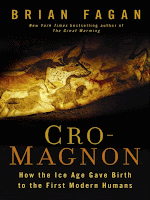I saw the book in the local library and read it to get up-to-date information on the rapidly-changing and controversial field of human prehistory. When I say controversial, by the way, I don't mean that human evolution is controversial - human evolution is a scientific fact. What's controversial are the interpretations of the bones and stone tools left for us to reconstruct the lives of our ancestors.
When exactly did different groups of hominids move out of Africa? How did Cro-Magnons and Neanderthals interact in Europe? Why did our ancestors make those hauntingly beautiful cave paintings in southwestern France? All questions that are argued about by modern-day archaeologists.
Two quick quibbles before I continue... I think this book would have benefited from a bit better editing. I found some sections to be repetitive - as if Fagan was padding for a higher word count - and the writing could certainly have been tightened up a bit. There were also sidebar boxes inserted throughout the book that weren't, in fact, sidebars but which were placed in such a way as to interrupt the narrative flow of the book since they sometimes extended across multiple pages.
What are Cro-Magnons? They're basically the earliest Homo sapiens in Europe (the word comes from a French rockshelter where bones were discovered). If you're from European ancestry, they are your direct ancestors.
The book discusses where they came from - East Africa - and how they migrated around the Mediterranean into Europe in waves. This story is complicated by the advances and retreats of the Pleistocene Ice Age. Europe was a very different place back then, more akin to Siberia at times when the climate was cooling. Also complicating the story are the interactions of Cro-Magnons with Neanderthals - an entirely different species of hominid we shared Europe with until around 30,000 years ago.
Fagan inserts a lot of opinion and conjecture in this book. Descriptions of what life was like and how Cro-Magnons and Neanderthals interacted with themselves and each other. Interesting but it does make one wonder how accurate these are even though Fagan is certainly knowledgable in his field. One thing I did find interesting was the claim that Cro-Magnons and Neanderthals didn't ever interact (or interbreed) with each other. There are some genetic studies indicating traces of Neanderthal DNA in modern Europeans although other researchers dispute the interpretations (maybe I'll post more about this later).
Anyway, it's a worthwhile read - just skim some of the more repetitive sections!




No comments:
Post a Comment